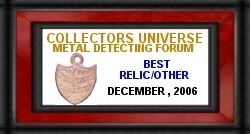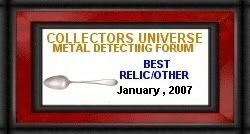I'M NEW.HOW MUCH DOES CLEANING HURT THE VALUE?
I acquired a 1912 Quarter Indian.
It is slabbed by NTC MS60 CLEANED. I just started collecting a few weeks ago ,which makes me
an idot at best in coin collecting. I traded an indian artifact for it,but only have $75 wrapped up in it.
Would appreciate any input.
thanks, goldrush
It is slabbed by NTC MS60 CLEANED. I just started collecting a few weeks ago ,which makes me
an idot at best in coin collecting. I traded an indian artifact for it,but only have $75 wrapped up in it.
Would appreciate any input.
thanks, goldrush
Analog Rules! Knobs and Switches are cool!




0
Comments
Glen
It takes time to learn the difference but as a rule of thumb only clean them if you
know what you're doing and only buy coins if you still like them despite a cleaning.
Don't be in a hurry to clean anything and most coins don't need it anyway.
The 2 1/2 dollar is a better gold piece and should probably be easily worth $75 even
cleaned.
Welcome aboard.
<< <i>The cleaning dosen't hurt as bad as the NTC holder it's in.
Glen >>
I agree that NTC isn't exactly the most trusted of the third party grading services. As to the value... it really depends on the severity of the cleaning. The fact that NTC actually marked it as cleaned probably means it is very harshly cleaned.
Still, you don't have too much to lose for $75, assuming it isn't a counterfeit.
Registry 1909-1958 Proof Lincolns
A silver coin and to a lesser extent a gold coin can be dipped to remove unsightly tarnish or in the case of gold, copper spots. If this is done properly it can make the coin more attractive, more saleable and potentially more valuable. Restorative work can also be done to remove dirt and other crud from the surfaces WITHOUT changing the surfaces. This procedure can also be beneficial.
Dipping copper coins is very dicey because the resulting red surfaces almost always look unnatural. Even after the coin retones, will look unnatural and therefore undesirable. Sometimes the second toning looks “pink” which is a real turn off for almost all collectors who fancy copper.
If a coin is dipped too many times, dipped for too long or dipped in a solution that is too strong, that can cause problems. Dipping solutions are made of acid, and if the process is not done properly damage can result. Usually the damage is in the form of white, dull surfaces on a silver coin.
The pejorative type of “cleaning” refers to the use of physical agents to remove or alter the surface of the coin. It can be as simple as using a pencil eraser to remove the surface oxidation to the use of abrasives like baking soda. Usually these procedures leave telltale scratches or hairlines that appear on the surface of the coin. If the damage is severe enough, PCGS and NGC will refuse to grade the coin and return it in a “body bag.”
Sometimes coin doctors try to restore the look of original surfaces by artificially toning the surfaces with chemicals or heat. Experienced dealers and collectors can often spot this, but sometimes the process works so well that even experts can be fooled.
<< <i>I acquired a 1912 Quarter Indian.
It is slabbed by NTC MS60 CLEANED. I just started collecting a few weeks ago ,which makes me
an idot at best in coin collecting. I traded an indian artifact for it,but only have $75 wrapped up in it.
Would appreciate any input.
thanks, goldrush >>
I will give a coin an acetone bath to remove PVC, glue, tape residue, etc., but I don't dip because the dipped copper I've seen just doesn't look natural (pink as Bill said above) A true copper coin collector can see this from across the room. I'd rather have a natural RB cent than a dipped "RD" (or should I say PNK?)
Mike
Lincoln Wheats (1909 - 1958) Basic Set - Always Interested in Upgrading!